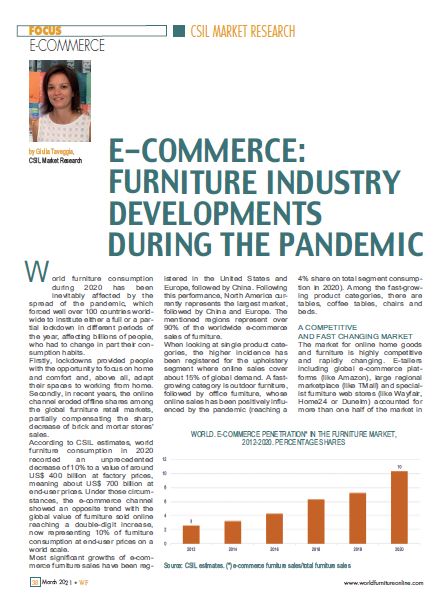E-commerce. Furniture industry developments during the pandemic

World furniture consumption during 2020 has been inevitably affected by the spread of the pandemic, which forced well over 100 countries worldwide to institute either a full or a partial lockdown in different periods of the year, affecting billions of people, who had to change in part their consumption habits.
Firstly, lockdowns provided people with the opportunity to focus on home and comfort and, above all, adapt their spaces to working from home. Secondly, in recent years, the online channel eroded offline shares among the global furniture retail markets, partially compensating the sharp decrease of brick and mortar stores’ sales.
According to CSIL estimates, world furniture consumption in 2020 recorded an unprecedented decrease of 10% to a value of around US$ 400 billion at factory prices, meaning about US$ 700 billion at end-user prices. Under those circumstances, the e-commerce channel showed an opposite trend with the global value of furniture sold online reaching a double-digit increase, now representing 10% of furniture consumption at end-user prices on a world scale.
The most significant growths of e-commerce furniture sales have been registered in the United States and Europe, followed by China. Following this performance, North America currently represents the largest market, followed by China and Europe. The mentioned regions represent over 90% of the worldwide e-commerce sales of furniture.
When looking at single product categories, the higher incidence has been registered for the upholstery segment where online sales cover about 15% of global demand. A fast-growing category is outdoor furniture, followed by office furniture, whose online sales have been positively influenced by the pandemic (reaching a 4% share on total segment consumption in 2020). Among the fast-growing product categories, there are tables, coffee tables, chairs and beds.
A COMPETITIVE AND FAST CHANGING MARKET
The market for online home goods and furniture is highly competitive and rapidly changing.
E-tailers including global e-commerce platforms (like Amazon), large regional marketplace (like TMall), and specialist furniture web stores (like Wayfair, Home24, or Dunelm) accounted for more than one-half of the market in 2020. Specialist furniture dealers/distributors operating through physical stores and e-commerce also called “brick & click”, represented another fast-growing category. Non- Specialist/Lifestyle/DIY chains are large multichannel dealers selling furniture, homewares, accessories, home improvement products. They made less than 20% of total sales in 2020.
Before the spread of Covid-19, only a few manufacturers operated their webshop and almost exclusively in North America with residential brands like Ashley, Ethan Allen, or La- Z-Boy or office furniture brands who acquired retailers like Herman Miller (DWR) or Knoll (Fully). Direct website is an issue for manufacturers as it often represents an obstacle in managing a good relationship with dealers. The majority of furniture manufacturers have web stores aimed at displaying portfolios and showing detailed product features.
However, according to furniture manufacturers continuing to develop their direct-to-consumer channel, an increasing trend is observed. Furniture manufacturers are investing in having their presence in the online world to strengthen brand awareness and increase their customer interaction. This trend includes mergers between furniture manufacturers and internet players and the expansion of own retail stores and online sales. This is the case, for example, of Italian high-end furniture players as Poltrona Frau, Molteni/Dada, Calligaris, and Kartell which launched their own websites.
A CSIL SURVEY
In November-December 2020 CSIL surveyed a sample of furniture manufacturers, collecting the opinion of about 100 respondents from all over the world.
In a nutshell: E-commerce was used by 62% of respondents in 2020, with a relevant difference among regions. Over 85% of manufacturers located in Asia-Pacific used e-commerce in the year 2020, while this percentage reduced to 75% for those based in North America and 52% for those in EMEA countries (Europe, Middle East, Africa).
It has to be pointed out that for most companies (36%), the web channel still represents less than 5% of revenues. Also, this channel’s presence strongly depends on the company dimension, with over 80% of large manufacturers already selling online. Only 44% of medium-small furniture companies are active through some form of web sales.
Almost 80% of companies currently not using e-commerce declared an intention to enter this channel within 2022. 39% of them will launch an owned platform, 33% will use e-tailers or “brick & click” dealers, while 28% expect to use both possibilities.
Among the most demanded product categories, there are: Chairs (14%), Home Office solutions (13%), and Beds (13%), Other Living Furniture and Tables (12% each) achieved the highest portion.
SOURCE: CSIL Report: E-commerce for the Furniture Industry, edition December 2020.
The report analyses the status and prospects of e-commerce for the furniture industry and consists of two parts.
PART I. E-COMMERCE FOR THE FURNITURE INDUSTRY deals with the incidence of the online channel in the furniture market focusing on key geographical areas (Europe, North America, Asia) and analysing different e-commerce business models and leading players’ performances. Current furniture consumption data and 2021 furniture market forecasts by region are included. Furniture e-commerce sales are provided by segment (upholstered furniture, outdoor furniture, office furniture, kitchen furniture, other furniture), by region and by distributor (E-tailers, Furniture distributors, Non-specialists/Lifestyle/DIY).
PART II. E-COMMERCE FOR THE FURNITURE INDUSTRY: SURVEY RESULTS. This part presents CSIL survey results to leading furniture manufacturers worldwide, aiming to understand their approach to the web channel, their strategies, future expectations, and the most demanded products.
